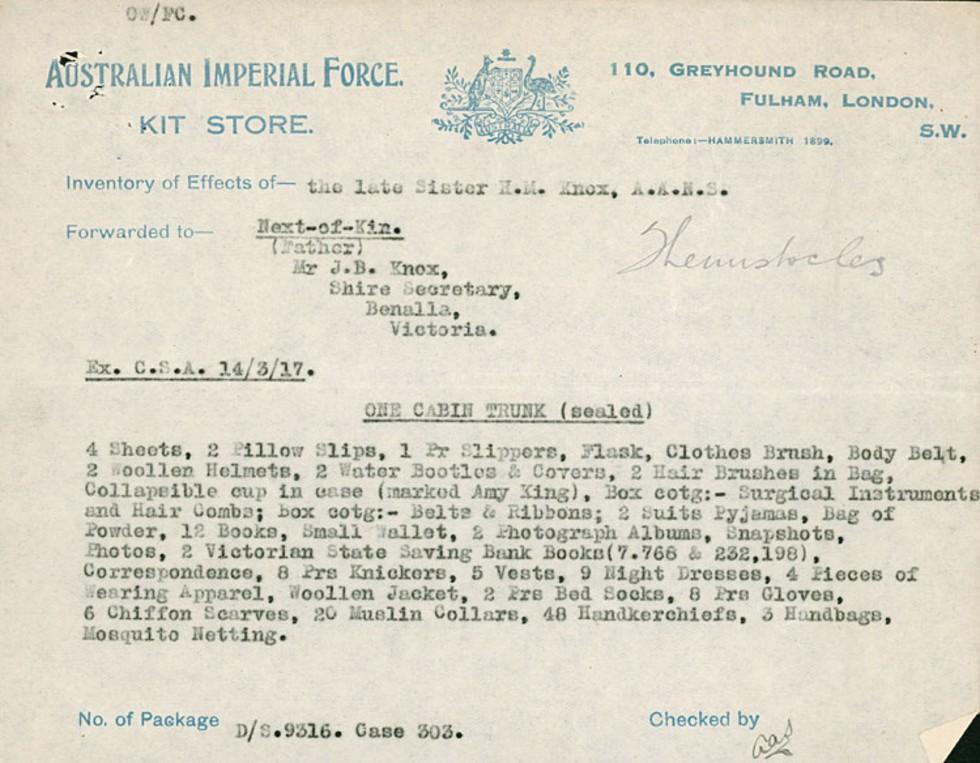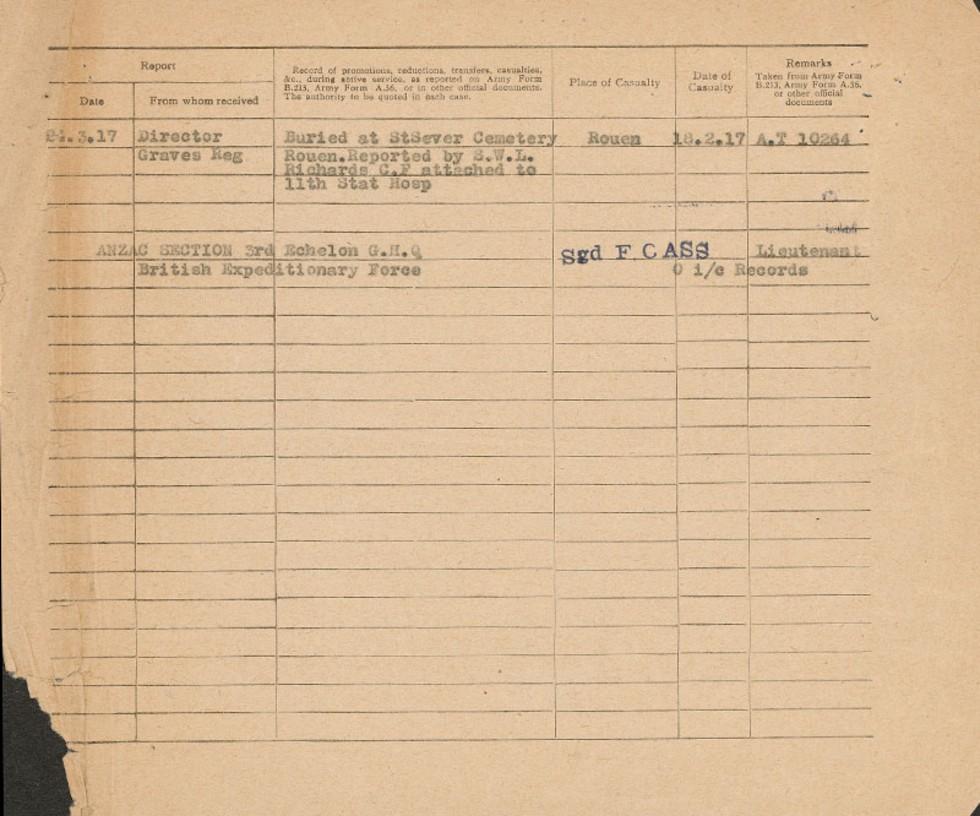


Aboriginal and Torres Strait Islander people should be aware that the National Archives' website and collection contain the names, images and voices of people who have died.
Some records include terms and views that are not appropriate today. They reflect the period in which they were created and are not the views of the National Archives.




[page 1, letter, white paper]
[Letterhead for the Australian Imperial Force, printed light blue ink, with the Australian Coat of Arms in the centre] Australian Imperial Force. Kit Store. 110, Greyhound Road, Fulham, London, S.W. Telephone:- Hammersmith 1899.
[printed light blue ink] Inventory of Effects of- [typed in black ink] the late Sister H.M. Knox, A.A.N.S. [end of black ink typing]
[printed light blue ink] Forwarded to -[typed in black ink] Next-of-kin
(Father)
Mr J B Knox,
Shire Secretary,
Benalla,
Victoria.
[handwritten, in pencil - illegible, possibly a name]
[typed in black ink, underlined] Ex. C.S.A. 14/3/17. ONE CABIN TRUNK (sealed) [end underlined]
4 Sheets, 2 Pillow Slips, 1 Pr Slippers, Flask, Clothes Brush, Body Belt, 2 Woollen Helmets, 2 Water Bootles [sic] & Covers, 2 Hair Brushes in Bag, Collapsible cup in case (marked Amy King), Box cotg:- Surgical Instruments and Hair Combs; box cotg:- Belts & Ribbons; 2 Suits Pyjamas, Bag of Powder, 12 Books, Small Wallet, 2 Photograph Albums, Snapshots, Photos, 2 Victorian State Saving Bank Books (7.766 & 232,198), Correspondence, 8 Prs Knickers, 5 Vests, 9 Night Dresses, 4 Pieces of Wearing Apparel, Woollen Jacket, 2 Prs Bed Socks, 8 Prs Gloves, 6 Chiffon Scarves, 20 Muslin Collars, 48 Handkerchiefs, 3 Handbags, Mosquito Netting.
[printed light blue ink] No. of package [typed in black ink] 'D/S. 9316. Case 303.
[printed light blue ink] Checked by
[handwritten initial, pencil]
[end page 1]
[page 2, printed form on brown paper, partially filled]
[Printed] Army Form B. 103.
[typed] A.A.N.S. [underlined] Attached 11th BRITISH STAT HOSPITAL [end underlined, typed]
[printed] Regimental Number… [blank] [end printed]
[typed, different ink] Casualty Form Active Service [end typed]
[printed] Regiment or Corps [end printed]
[typed] No 14 A.G. Hospital A.I.F [crossed out with red ink] [end typed]
[printed] Rank [end printed] [typed] Sister [end typed] [printed] Surname [end printed] [typed] Knox [end typed] [printed] Christian Name [end printed] [typed] Hilda M [end typed] [printed] Religion [end of printed] [typed] C of E [end typed] [printed] Age on Enlistment [end printed] [typed] 30 [end typed] [printed] years [blank] months
Enlisted; (a) [end printed] [typed] 19.8.16 [end typed] [printed] Terms of service(a) [blank] Service Reckons from (a) [blank] Date of promotion to present rank [blank] Date of appointment to lance rank [blank] Extended [blank] Re-engaged [blank] Qualification (b) [blank] or Corps Trade and Rate [blank] Occupation [blank] [blank] Signature of Officer.
[The bottom part of the form is printed in columns under relevant headings of 'Report' with subheadings 'Date' and 'From whom received'; 'Record of promotions, reductions, transfers, casualties &c. during active service, as reported on Army Form B.213, Army form A.36, or in other official documents. The authority to be quoted in each case'; 'Place of Casualty'; 'Date of Casualty'; 'Remarks Taken from Army Form B.215, Army Form A.56, or other official documents.']
[printed] Embarked [end printed] [typed] Melbourne 19/8/16 [end typed]
[printed] Disembarked [end printed] [typed] Suez 20.9.16
20.1.17[;] 14th A.G. Hosp[;] Struck of strength Trans to H.S. "Essequibo"[;] Abbassia[;] 16.1.17[;] B213 LH23 D/05/513
Nom Roll H.S "Essequibo"[;] Embarked for England[;] Alexandria[;] 16.1.17[;] L.P75 D/05/274
3.2.17[;] Matron in chief Adm H'Qrs[;] Arrived in England for Imperial Service in France[;] England[;] 26.1.17
3.2.17[;] -do- [;] Left England for duty in France[;] -do- [;] 8.2.17
24.2.17[;] R.A.M.C. Sect[;] Attached to 11th British Stat Hospital[;] Rouen[;] 11.2.17[;] ARS 170/40/1, D/01/152 [handwritten] 3.7.17 [end handwritten]
20.2.17[;] 8th General Hospital Telegram[;] died of Disease Cerebral N.Y.D en route to 8th Gen Hosp admitted dead at 1915[;] Rouen[;] 17.2.17[;] AT9156, VL263
[Form torn bottom right corner, some text is illegible]
[fine print at bottom of page, faded] (a) In the case of a man who has re-engaged for, or enlisted into Section D, Army Reserve, particulars of such re-engagement or enlistment will be entered.
(b) Signaller, Shoeing Smith, &c.
[illegible letters and numbers]
[partially visible 'P.T.O', bold]
[end page 2]
[page 3, other side of form]
21.3.17[;] Director Graves Reg[;] buried at St Sever Cemetery Rouen. Reported by S.W.L. Richards C.F attached to 11th Stat Hosp[;] Rouen[;] 18.2.17[;] AT 10264
ANZAC SECTION 3rd Echelon GHQ, British Expeditionary Force[;] Lieutenant 0 i/c Records
[blue ink stamp reads 'Sgd F.CASS']
This inventory details the contents of Sister Hilda Mary Knox’s cabin trunk at the time of her death in 1917. Knox, a member of the Australian Army Nursing Service, is believed to have died from cerebrospinal meningitis while serving in France. The list (part of her First Australian Imperial Force personnel dossier) includes surgical instruments, mosquito netting and clothing, as well as personal items such as hairbrushes, books and photo albums. The contents were eventually sent to her father, James B Knox, in Benalla, Victoria.
Learning resource text © Education Services Australia Limited and the National Archives of Australia 2010.
Learn how to interpret primary sources, use our collection and more.
